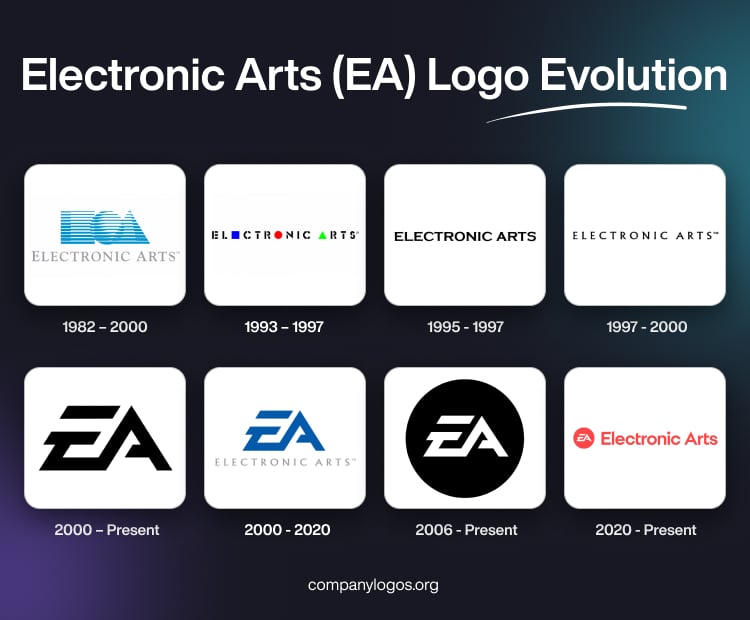
Electronic Arts (EA) is arguably one of the most influential companies in the video game industry. Since its founding in 1982, EA has played a critical role in shaping the landscape of interactive entertainment. It began as a champion of game developers and has since evolved to become a global publishing powerhouse.
The Electronic Arts (EA) logo is one of the most recognisable emblems in the gaming industry, which symbolises decades of innovation, creativity, and global influence. The logo has undergone several new iterations to reflect the growth, technological advancements, and the evolving brand identity of the company. The article delves into the various logo changes of the company, among others details, over the years.
The Genesis of the Electronic Arts (EA) Logo (1982 – 2000)
The first EA logo was introduced in 1982, and it was a geometric and conceptual design. It featured the light grey inscription “Electronic Arts” in uppercase beneath three distinct shapes in blue and white: a square, a ball (circle), and a triangle. These shapes symbolised the three pillars of the company’s philosophy—creativity, technology, and entertainment.
The colour blue was used for the emblem, as the colour is associated with communication, networks, and mental processes. This original logo was known for its abstract, almost artistic approach. It aligned with EA’s early vision of treating developers as “software artists” and positioning the company at the forefront of digital creativity.
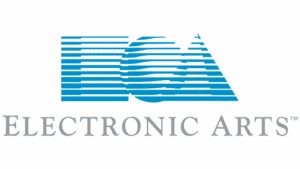
(1993 – 1997)
The 1993 logo showed the brand name in a contrasting colour scheme. The square (in blue), ball (in red), and triangle (in light green) were made smaller and incorporated in the brand name. These geometrically shaped figures in their miniature forms replaced certain letters in the wordmark. For instance, the square represented the letter “e”, the circle represented the letter “o”, and the triangle represented the letter “a”. The typeface to write the brand name looked like a stencil having short broken lines.
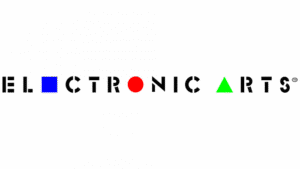
(1995 – 1997)
The 1995 logo iteration showed a simple wordmark in black against a white background without any graphical element. The font used to write the wordmark was geometric with long and thin serifs, which was similar to Copperplate FS Bold from FontSite Inc.
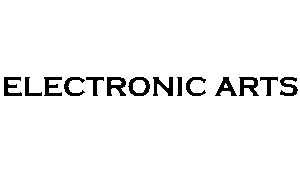
(1997 – 2000)
The 1997 logo refined the previous version, comprising the brand name using a classic serif typeface in black. The best part of the logo remained the elongated serifs adorning the ends of the bars.
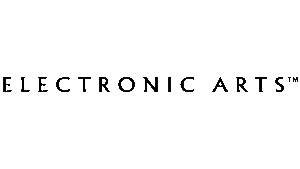
(2000 – Present)
In 2000, EA, especially its Sports division, came up with a creative monogram formed out of the interconnected letters “E” and “A” in black uppercase. Crafted in a thick and bold geometric style, the letter “E” appeared to be broken at the top, and the bottom half was fused to the bottom of the letter “A” to form a monogram. In fact, the letter “E” was formed of two thick and wide parallel stripes. The letter “A” did not look conventional, as its horizontal bar with a slanted cut did not meet the left leg of the letter.
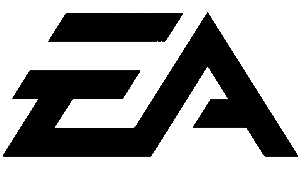
(2000 – 2020)
Another logo iteration of the era consisted of the “EA” monogram in blue. Mirroring its other version, this logo in light blue had the brand name written below in light grey using asymmetric serifs. The font similar to it is Fremont Regular from FontSite Inc.
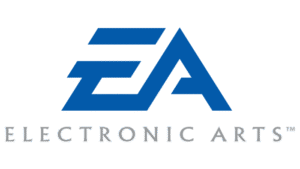
(2006 – Present)
In the 2006 logo variant, the stylised “EA” monogram in white is enclosed within a solid black circle. So, even though the colour palette and typeface were similar, the logo looked different and more confident.
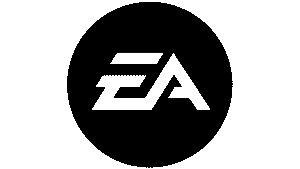
(2020 – Present)
The current logo is a combination of the “EA” monogram and the brand name, albeit in a new colour palette of coral red. The stylised white monogram was placed within a coral red circle to the left, and the brand name in the same colour palette and using a modern, strong sans-serif typeface, to the right.
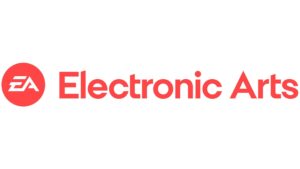
The Elements of the Electronic Arts (EA) Logo
Font
The logo of Electronic Arts has the letters “E” and “A” arranged in a distinctive, italicised style. The letter “E” is crafted from two parallel horizontal lines that are joined by a sharp angle. The letter “A” seamlessly connects to the lower end of this angle to create the impression that it is an extension of the letter “E”. Inspired by this unique typographic approach, designers on platforms like Behance and 538Lyons developed a similar typeface, which they referred to as the EA emblem font.
Colour
The current logo of Electronic Arts is rendered in a timeless monochrome scheme as well as coral red. It uses black and white and coral red for maximum versatility and visual clarity across any background. This minimalist colour palette marks a departure from the earlier logos of EA, which prominently featured bold, contrasting colours such as blue, red, and green.
The History of Electronic Arts (EA)
EA was founded in May 1982 by Trip Hawkins, who was a former marketing director of Apple. He founded it along with his Apple colleagues, Bing Gordon and Tom Mott. Hawkins was inspired by the idea of treating software as an art form. Initially, he thought of naming the company “Amazin’ Software” and then “SoftArt”, before settling on “Electronic Arts”. The name was arrived at after a brainstorming session with early employees and marketing advisors.
The company started with a small team and $5 million in private investment. In fact, Hawkins personally invested $200,000 and spent months refining the business plan. He eventually secured additional funding from prominent venture capitalists. EA was unique from the start and focused exclusively on developing and publishing games for home computers rather than proprietary hardware. It emphasised the creative contributions of individual game designers.
The first products of EA were released in 1983. These included titles for the Atari 800 and Commodore 64. The company quickly adapted to market shifts and released multiple versions of its games for different platforms. It thus gained a reputation for flexibility and innovation.
Throughout the 1980s, EA expanded its catalogue with successful titles like “Archon: The Light and the Dark”, “One on One: Dr J vs Larry Bird”, and “Marble Madness”. EA’s “Skyfox” for the Apple II became a bestseller in 1984, and the company was quick to embrace new hardware such as the Commodore Amiga.
In the late 1980s and early 1990s, EA made a strategic move into the console market. It developed games for Sega Genesis and later for Nintendo systems. EA’s sports titles, particularly for the Genesis, were a major factor in the platform’s success. Soon, the company became the leading independent developer for 16-bit consoles. By 1992, the sales of cartridge-based games overtook the sales of floppy discs for EA, and the company’s revenues soared. These were largely driven by the popularity of its sports franchises.
The success of EA in the sports genre was cemented with licensing agreements with major leagues like the NFL, NHL, and FIFA. It led to the creation of iconic franchises such as “Madden NFL”, “NHL”, and “FIFA”, which became industry benchmarks. The company also began acquiring other studios to diversify its portfolio. Some of the key acquisitions included Maxis (creator of “SimCity”) and Westwood Studios (known for “Command & Conquer”). These expanded EA’s influence into simulation and strategy games.
In 1994, EA signed a licensing agreement with THQ to develop and release its titles for various consoles. The company continued to grow and moved its headquarters to Redwood Shores, California, in 1998. It adopted a brand-specific structure with labels like EA Sports, EA Games, and EA Sports Big. EA also entered the digital distribution space by acquiring Pogo.com in 2001 and later the social gaming startup Playfish in 2009. These acquisitions reflected an early recognition of the importance of online and social gaming.
EA has maintained its position as a dominant force in the industry through continued innovation, high-profile acquisitions, and adaptation to new gaming trends. The company has faced challenges, including workforce reductions and restructuring. However, it has remained a leader in both console and digital gaming. EA’s commitment to the industry is also reflected in its support for game development education. These included its multimillion-dollar donation to the University of Southern California’s Interactive Media Division in 2004.
Today, EA is known for its vast portfolio of successful franchises, which includes “The Sims”, “Battlefield”, and “Apex Legends”. These are in addition to its enduring sports titles. The company continues to evolve by embracing new technologies and platforms while maintaining its legacy as a trailblazer in interactive entertainment.
Interesting Facts About Electronic Arts (EA)
- EA was founded in May 1982 by Trip Hawkins, a former Apple employee. He envisioned treating game designers and programmers as “software artists” and elevated their creative status in the industry.
- The company shipped its very first games on May 20, 1983, with the entire small team personally packing and loading boxes in a warehouse. Later on, the employees received T-shirts featuring “I survived” to celebrate the milestone.
- EA was one of the first publishers to prominently feature the names of game creators on the front of game packaging. It thus gave credit to the creators similar to that of rock album artists, which was a novel approach at the time.
- In 1994, EA signed a licensing agreement with THQ to develop and release titles like John Madden Football, FIFA International Soccer, and Shaq Fu for various consoles. It helped EA to expand into the console market.
- EA was recognised in 1995 as the best software publisher of the year at the European Computer Trade Show. This achievement highlighted its rapid rise and influence in the gaming industry.
- The company moved its headquarters to Redwood Shores, California, in 1998, where it remains a major hub for game development and publishing.
- EA was the only company identified by Next Generation magazine in 1997 for profiting from video games over the previous five years. This underscored its consistent business success.
- The company pioneered online gaming with titles like Ultima Online in 1997, which was one of the first massively multiplayer online games. Later, it acquired Mythic Entertainment, the creators of Dark Age of Camelot.
- EA acquired the popular online gaming site Pogo.com in 2001 and the social gaming startup Playfish in 2009. These showed early recognition of the importance of online and social gaming platforms.
- EA’s sports franchises, including Madden NFL, FIFA, and NHL, have become some of the best-selling and longest-running sports video game series in history.
- The company’s early embrace of multiple platforms—from home computers to consoles and online—helped it grow from a small startup into the world’s largest video game publisher within 25 years.
Finally
The EA logo and its variations show the journey of the company from a pioneering software house to a global leader in interactive entertainment. Each iteration of the logo has balanced simplicity, symbolism, and adaptability. It has ensured the EA brand remains fresh, relevant, and instantly recognisable to gamers worldwide.